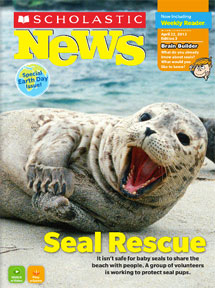Apr 2013
Year of the Seal sculpture and educational projects on track
Apr/28/13 04:45 PM
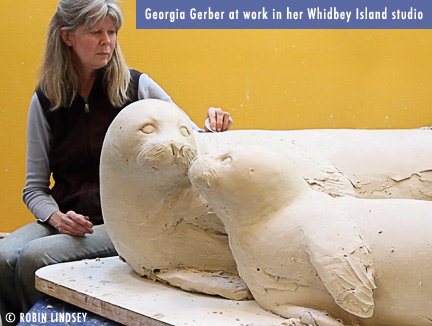
The intent of the sculpture is to raise awareness about the health of our marine ecosystem. Harbor seals, who live year round in our waters, are a sentinel species for the Salish Sea. Dangerous toxins in Puget Sound are stored in the blubber of marine mammals such as seals and cetaceans. The sculpture will remind people not only to Share the Shore with wildlife, but to make conscious choices to help clean up our waterways. The sculpture will be in place during the height of harbor seal pupping season in West Seattle. Seal Sitters volunteers will have the opportunity to have this dialogue with literally thousands of people while protecting pups on our beaches.
Another exciting facet to the project is the educational outreach to elementary schools due to begin in May. Seal Sitters will be talking to young children about ways they can truly make a difference for the marine environment. A few of the simple ways kids (and all of us) can help? First of all, don’t litter. Litter on the ground miles away from Puget Sound can end up in it by way of wind, storm drains and streams. Pick up litter on the street and beach - a glass bottle lasts 1million years. A styrofoam cup, 500 years. Don’t use balloons or “sky” candle lanterns to celebrate a birthday. What goes up truly must come down, often into the water. Beautiful flying candle lanterns are simply ugly trash when they land. Even if the package says “biodegradable” that process takes many, many years. Tragically, balloons in the water are often mistaken for jellyfish and swallowed by marine mammals and sea turtles, causing suffocation. We’ll offer kids positive and empowering ways to help protect and preserve our marine life for generations to come. Learn more about marine pollution here.
Seal Sitters needs to fundraise thousands of dollars to supplement our Department of Neighborhoods grant for the sculpture phase of the project. These dollars will be used for site preparation, landscape materials and installation. The Year of the Seal sculpture will be dedicated at a celebration event on September 8th. Also highlighted at the event will be children’s essays and artworks inspired by the project, environmental groups with outreach tables, speakers and fun, interactive stuff for kids - more info to come. Please click here to make a donation.
A public meeting will be held on Monday, May 13th from 7-8pm at the Alki Bathhouse to present the project to the community. Please attend. We welcome your input!
Seal pup keeps volunteers on their toes
Apr/25/13 07:28 AM
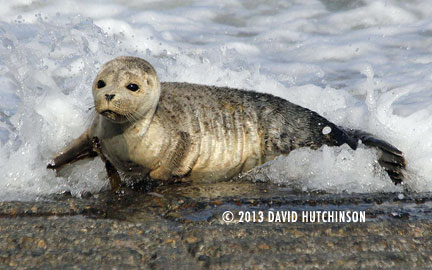
The day began with a report of a pup at the small cove near Salty’s restaurant. Our responder quickly was on the scene and taped off a perimeter. Soon after, the pup returned to the water, but only briefly before popping ashore at the north end of Harbor Avenue. Along the way, she enjoyed a short stop at Don Armeni boat ramp - keeping our first responder scrambling. Nicknamed Kellogg (after the pop tarts), she returned to Elliott Bay when the tide forced her from the beach. Kellogg headed south and ended up back at the boat ramp (photo above) where boaters were very cooperative in efforts to help the thin pup get some rest. They launched quietly from the opposite ramp. Finally, the exhausted pup settled in for a lengthy snooze late into the night as volunteers watched over her in shifts. The boat ramp area can be quite busy at night with people and vehicles.
The pup was still on the beach at sunrise this morning, but returned to the water for breakfast around 6:30 am. Ever on the move, Kellogg came back to Don Armeni a bit later, left at 10 am and, thankfully, was sighted around noon on the protected beach at Jack Block Park - a much safer location. It was an exhausting and stressful two days for our responders. Thanks to the many volunteers for protecting this pup, obviously in need of time on shore to rest and warm up!
Year of the Seal kickoff event a success
Apr/24/13 08:25 AM
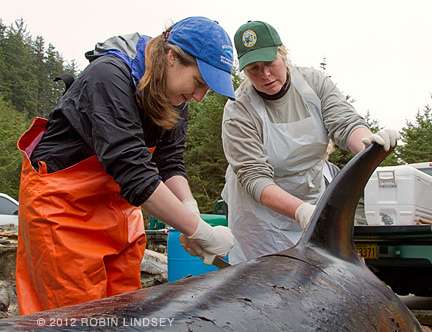
The Year of the Seal educational outreach project is intended to raise awareness of human impact on our fragile marine ecosystem - and that one person truly can make a difference by the choices we make regarding litter and plastics, pesticides and fertilizers. Click here to learn more about the project and sculpture by Northwest artist Georgia Gerber. Thanks to the volunteers at the event who made a donation to help us raise funds for the landscape and installation phase of the sculpture project.
Huge thanks to Dyanna and Jessie for giving up their Saturday to educate our volunteers who were fascinated by this glimpse into the world of marine mammal “CSI”. The funding for research into emerging diseases, contaminants and methods to help alter the deadly collision course of whales and shipping vessels is largely made possible by the John H. Prescott Fund, which has been eliminated from the proposed 2014 Federal buget. For more information and links to contact your congressional representatives asking to reinstate Prescott funding, click here.
Seal Sitters kids featured in Scholastic Mag's Earth Day Issue
Apr/17/13 09:22 AM

The Earth Day issue has just been posted online. Read the cover story here about our inspiring kid volunteers and the important work they do to help protect seal pups (and elephant seals and sea lions and....). The magazine goes out to 550,000 classrooms across the U.S.
Congratulations to Noemi and all our kid volunteers for the tremendous work they perform on our beaches. Talking to passersby about why pups are on shore and the need to keep dogs leashed at all times, these young environmental stewards raise the bar for all of us! You can read about some of our newest cool kid volunteers here.
NOTE:
SS kids Noemi, her big sister Etienne and Miles are featured in the children’s book about seal pups, Leopard and Silkie (ages 4-8), also now available in a Young Reader version. You can read more about our young Seal Sitters and the many ways kids can help wildlife on the Leopard and Silkie website.
Dead fin whale successfully towed to remote location
Apr/17/13 07:26 AM
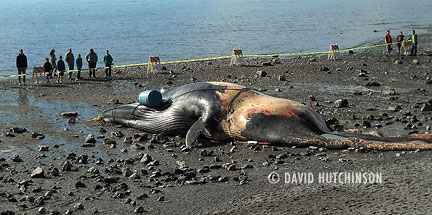
We received a call yesterday morning from NOAA NW MMSN stranding expert Kristin Wilkinson, inquiring if our volunteers could assist neighboring stranding network MaST (which covers south of Brace Point to Redondo) that afternoon on the Burien beach. We replied with an enthusiastic yes. Kristin said the logistics of removing the dead fin whale from the beach had been worked out and there was a need for volunteers to inform the public about the process and for crowd control. Global Diving and Salvage, hired by the City of Burien, would arrive in the afternoon to harness the huge animal, now resting high on the beach, prepare the whale for removal and return at high tide late in the night. The animal would then be towed to an island in South Puget Sound.
Seal Sitters volunteers arrived on scene at 1pm to find the perimeter (established by Parks on Monday after a mob scene the day before, fueled by tv coverage of the stranding) torn down in one area and the whale surrounded by people inside the “danger - do not enter” tape. Seal Sitters David and Buzz managed to move the crowd safely away and re-taped the open section of the perimeter near the tail. It is surmised that the whale shifted position at the earlier high tide and the tail broke the tape. Soon after, more SS volunteers arrived along with those from MaST and beach naturalists. Throughout the afternoon, they educated hundreds of curious observers on the biology of endangered fin whales, the dangers of ship strikes and the logistical challenges of moving such an immense whale.
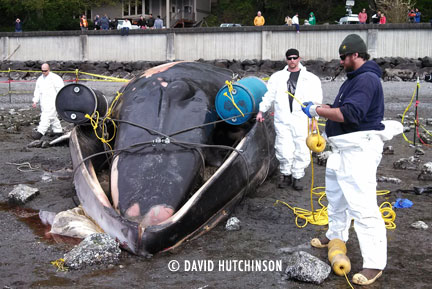
The salvage company returned at about 10 pm last night and the tow was underway. Seal Sitters received word at 7:30 this morning that the whale was secured at the remote location where it will decompose naturally. The skull will be retrieved at a later date for research and educational purposes. This afternoon, members of WDFW-MMI and Cascadia will take more scientific samples.
Congratulations to Kristin, the cooperative efforts of the many stranding network members, beach naturalists and the City of Burien/Parks in this very complicated and demanding task.
Challenging situation to remove dead fin whale from beach
Apr/15/13 01:05 PM
NOAA’s NW Marine Mammal Stranding expert reports that they are working with several groups, including the City of Burien and Burien Parks and Recreation, to find a solution to both crowd control and the removal the fin whale that washed ashore Saturday at Seahurst Park. Large whale strandings are extremely complicated situations, usually taking a minimum of 3-5 days to resolve. Since the backbone and rear half of the whale is missing, towing the whale either to another location for necropsy or to sink in the Sound is difficult. There is no tail fluke to tie rope to and towing the whale by the head causes too much drag for many vessels to handle. With very limited funding for marine mammal strandings, NOAA is working to find an educational or scientific facility interested in obtaining the huge, intact skull and potentially help with the logistics of removal.
After a chaotic Sunday with hundreds of onlookers at the beach (many with young children touching and climbing on the whale), Burien Parks is establishing a tape perimeter with signage, in hopes to keep people safely away from the immense whale. Marine mammals can carry infectious disease. Touching the animal carcass or blood and bodily fluids is inherently dangerous. Please admire this magnificent whale from a safe distance.
ADDITIONAL NOTE 10:26 pm
Like Seal Sitters, most marine mammal stranding networks across the region (and nation) are all-volunteer with little or no funding and paid staff. Some networks are smaller than others and volunteers are not always available. Not every network can have a dawn to dusk presence on site.
Seal Sitters MMSN responds to marine mammals, dead or alive, from Brace Point (just south of the Fauntleroy ferry dock) and all West Seattle shoreline through the Duwamish River (including Harbor Island). If you see a marine mammal on the beach, please call our dedicated hotline 206-905-7325 (SEAL).
After a chaotic Sunday with hundreds of onlookers at the beach (many with young children touching and climbing on the whale), Burien Parks is establishing a tape perimeter with signage, in hopes to keep people safely away from the immense whale. Marine mammals can carry infectious disease. Touching the animal carcass or blood and bodily fluids is inherently dangerous. Please admire this magnificent whale from a safe distance.
ADDITIONAL NOTE 10:26 pm
Like Seal Sitters, most marine mammal stranding networks across the region (and nation) are all-volunteer with little or no funding and paid staff. Some networks are smaller than others and volunteers are not always available. Not every network can have a dawn to dusk presence on site.
Seal Sitters MMSN responds to marine mammals, dead or alive, from Brace Point (just south of the Fauntleroy ferry dock) and all West Seattle shoreline through the Duwamish River (including Harbor Island). If you see a marine mammal on the beach, please call our dedicated hotline 206-905-7325 (SEAL).
Seal pals enjoy sunny day
Apr/14/13 09:29 PM
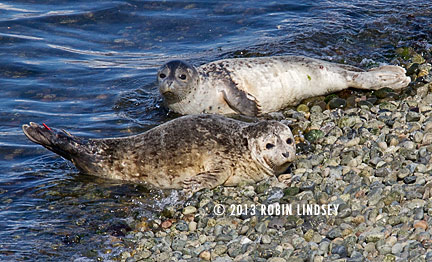
Rehab Ruby (in front, showing off her red flipper tag) has become somewhat of a celebrity, featured in this month’s issue of PAWS Magazine. She was taken to PAWS Wildlife Center at only 1 week old, abandoned on a beach in Steilacoom after being harassed by people. After her release back to a South Puget Sound harbor seal rookery in October, she made her way north several months later to the shores of Elliott Bay. She has found quite the friend in Buddy, who hangs out with her most every day at Jack Block. Seal Sitters volunteers have been monitoring both pups’ health over the past months. Read more about Ruby’s travels here.
Dead fin whale washes ashore in Burien, victim of ship strike
Apr/13/13 11:57 PM
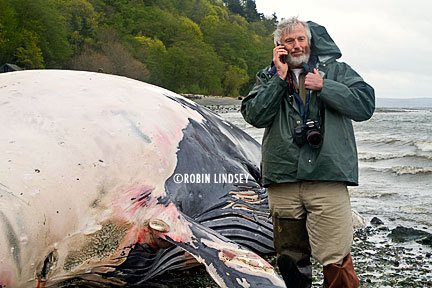
A dead adult fin whale, the apparent victim of a ship strike, washed onto the beach of Seahurst Park mid-morning today. Biologist Dyanna Lambourn and interns from WA Dept. of Fish and Wildlife Marine Mammal Investigations (WDFW-MMI), Cascadia Research biologists John Calambokidis and Jessie Huggins, and staff and students from MaST Center of Highline Community College examined the whale and answered questions from the public. Seal Sitters volunteers participated as well.
Most of the rear half of the whale was missing, but the animal was estimated to have been approximately 65 ft in length when intact. Fin whales are the second largest species of whales with a maximum length of 75 ft. Bruising from brunt force trauma is an indication that the whale was still alive when struck by the bow of a large ship. Red paint from the ship was on the whale’s body. Fin whales, an endangered species, are susceptible to mortal wounds because of their size and their tendency to feed near the water’s surface. Since 2002, Cascadia reports there have been 10 stranded fin whales in Washington waters, 8 of which had evidence of vessel collisions (including today’s whale).
These large baleen whales are vulnerable to ship strikes as they travel in waters along our Pacific coast, particularly in busy shipping lanes such as Los Angeles and Long Beach, California. Gray whales and their calves migrate from Baja California to Alaska through these containership congested waters. Blue whales, the largest of all cetaceans and listed as endangered, are in peril of deadly collisions as they forage on krill in the shipping lanes. In 2007, three blue whales were struck and killed by ships in the Santa Barbara Channel.
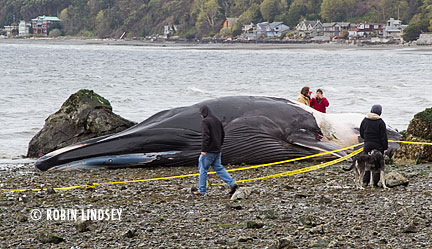
The WDFW-MMI and Cascadia team is making efforts to have the animal towed to a remote location for necropsy. Read Cascadia’s preliminary report here. Studies by both Cascadia and WDFW-MMI on whales and vessel interactions can be found on Cascadia’s website.
Responses such as this by members of NOAA’s NW Marine Mammal Stranding Network are in large part funded by the John H. Prescott Fund, which has been eliminated from the 2014 fiscal year Federal budget. Contact your congressional representative here, asking that this critical funding be restored.
RELATED NEWS MEDIA LINKS
KING 5 TV
KOMO 4 TV
UPDATE 4/15/13
NOAA’s NW Marine Mammal Stranding expert reports that they are working with several groups, including the City of Burien and Burien Parks and Recreation, to find a solution to both crowd control and the removal the fin whale at Seahurst Park. Large whale strandings are extremely complicated situations, usually taking 3-5 days to resolve. Since the backbone and rear half of the whale is missing, towing the whale either to another location for necropsy or to sink in the Sound is difficult. There is no fluke to tie rope to and towing the whale by the head causes too much drag for most vessels to handle. NOAA is trying to find an educational or scientific facility interested in obtaining the skull.
After a chaotic Sunday with hundreds of onlookers at the beach, many touching and climbing on the whale, Parks is establishing a tape perimeter with signage, in hopes to keep people safely away from the immense whale. Marine mammals can carry infectious disease. Touching the animal carcass or blood and bodily fluids is inherently dangerous. Please admire this magnificent whale from a safe distance.
Act now - marine mammal funding eliminated from Fed's budget
Apr/12/13 01:53 PM
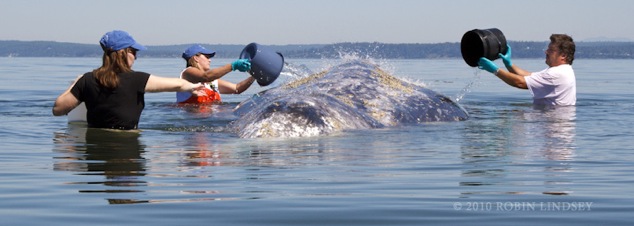 (update: Prescott will be included in the 2014 budget, but funding is greatly slashed)
(update: Prescott will be included in the 2014 budget, but funding is greatly slashed)Yesterday it was learned that critical funding for marine mammal stranding response and research has been eliminated from the proposed fiscal year 2014 Federal budget and NOAA budget. Nationwide, marine mammal stranding networks are run through non-profits and other non-government entities and coordinated through NOAA’s National Marine Fisheries Service (NMFS). These networks are heavily dependent on funding from the John H. Prescott Marine Mammal Rescue Assistance Grant Program.
Stranding networks are the nation’s first responders to both live and dead marine mammals that come ashore (or are entangled off shore), often in urban coastal communities. Responders are usually the only means of intervention between wild and potentially dangerous marine mammals and a curious, but largely unwitting, public. Additionally, network responders collect biological specimens from stranded animals to monitor emerging, infectious, and zoonotic (transmissible to people) diseases in areas frequented by the public.
Infectious diseases have been showing up in marine mammals at an alarming rate in recent years. Network responders play an essential and unique role in identifying dangerous pathogens in marine mammals that share our shores. Their work is not only necessary for minimizing risks to public health and safety, but for developing a better understanding of the health risks facing these animals and our marine ecosystem.
Marine mammals are sentinels for the health of our oceans - and our first line of detection of ominous changes in the marine environment.
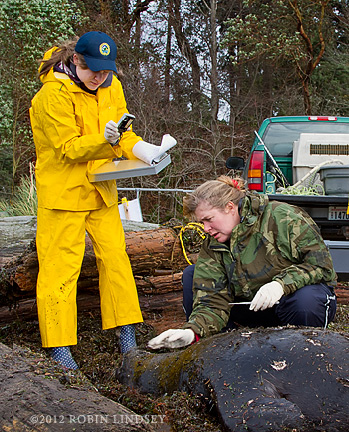
The public demands a response to marine mammals in need and the elimination of Prescott Funds for response and research will drastically impact this ability. There will be severe public backlash when animals cannot be responded to at the level the public expects. For both public and animal safety, strandings are best responded to by trained individuals. Without a professional response to strandings, the public will resort to taking matters into their own hands, with the potential for injury or death to humans.
Rehabilitation facilities across the country also depend on Prescott Funding for their work and will be severely compromised. Some will close. Many largely-volunteer networks will cease to exist without this funding.
Please contact your congressional representative and stress the need for Prescott Funds to be reinstated for this essential work. The Prescott Fund is a minute percentage of the Federal budget. International Fund for Animal Welfare (IFAW) has an easy method to contact Congress and make your voice heard. Please click here to act now!
You can also contact the President via the White House website. Click here to ask President Obama to reinstate the John H. Prescott Grant Program.
NOTE:
Seal Sitters receives no Prescott Funding (or financial support from any Federal, State or City agencies) for our work. We rely on public contributions for our stranding response and educational outreach. If you’d like to make a donation, please click here.
Read here about Seal Sitters’ Year of the Seal grant project, designed to raise awareness about human impact on marine mammals and the health of our marine ecosystem.
Cool kids protect wildlife
Apr/10/13 09:17 PM
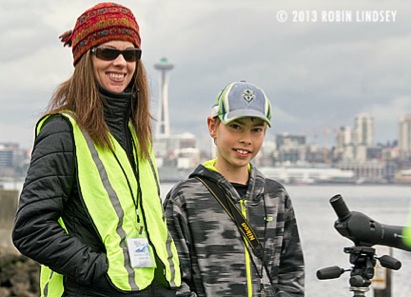
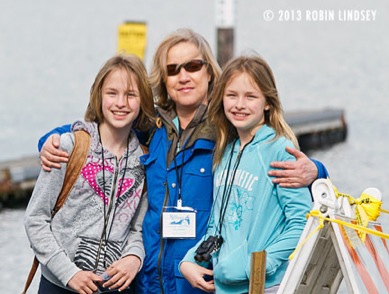
The boat ramp is an inherently dangerous place for a seal pup to snooze. With cars driving through the parking lot, boats and trailers in an out of the launch area, and people walking dogs, it would be easy for a pup to get chased back into the water or possibly be injured. All the more reason to have vigilant volunteers on hand. Thankfully, yesterday was a slow day for boat traffic and Truffles was able to extend his siesta til late in the evening. We have not seen Truffles since Monday night, but have been on the lookout for him with his distinct balding coat (see earlier post).
While our volunteers were admiring the Seattle skyline and Truffles’ stretches and yawns, we were alerted that there was an injured Canada Goose nearby. The severely bleeding adult bird was captured by Seal Sitters - volunteers David and Eilene kept the goose from returning to Elliott Bay, James gently subdued him with a towel and we managed to get him into a kennel and transferred to PAWS in Lynnwood. Kudos to the goose-wrangling team! We will keep you posted as we hear more about the bird’s condition and possible cause of the bloody wound.
Volunteers enjoy special treat of Truffles
Apr/08/13 10:42 PM
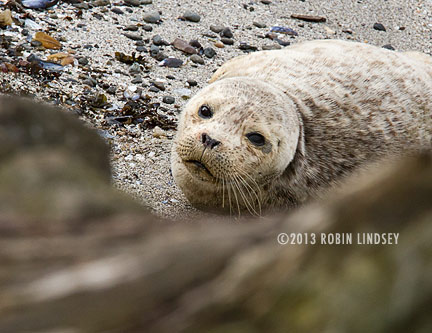
In a frigid downpour, the first responder established a protective tape barrier to keep people from disturbing the pup, hidden among the rocks near the water’s edge. Nicknamed Truffles, volunteers watched over him in a steady rain until around 1pm when the incoming tide washed over his flippers and he swam off into the Sound.
Around 5pm, hotline operator Julia received another call of a pup at Don Armeni Boat Launch. Our responder found Truffles snoozing behind a log. Once again, tape and barricades were stretched around the area, providing a safe buffer zone for the pup to rest. Photographs of Truffles’ coat with significant balding patches on the neck, flipper and belly were sent to WDFW’s marine mammal biologist for input. We have seen several West Seattle seals in recent years with a similar condition. The most likely cause is a fungal infection, much like ringworm. The condition can be complicated with a bacterial infection and can also be caused by thyroid issues. We are keeping a close eye on Truffles’ health.
Truffles was still sleeping onshore late last night, but was gone at 5:30 this morning. About 15 minutes after our first responder removed all the tape and barricades, Truffles reappeared (of course) and flopped onshore behind the same log. The perimeter was reestablished and volunteers were lined up to protect him throughout the day and long into the evening. We expect to see Truffles again tomorrow morning. She looked thinner today and had some coughing bouts, so we hope she is out foraging tonight, packing on some blubber by eating small fish, shrimp and squid. Blubber will not only help keep her warm in the bitter cold waters of the Sound, but also provide energy and help boost her immune system.
Ruby and Buddy enjoyed a sunny day on Jack Block Park’s protected beach and were still there at last report around 5:30.
Seal Sitters featured on KCTS tv channel and website
Apr/05/13 06:28 AM
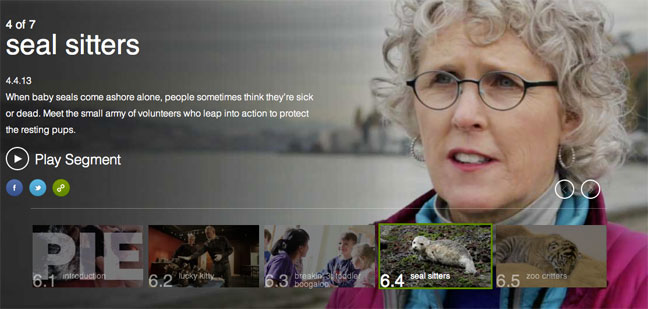
A documentary segment on Seal Sitters, filmed last fall, is currently featured in KCTS-9’s email campaign and is airing this week on the PBS program PIE. Environmental filmmakers Katie Campbell and Michael Werner covered our story of 2012’s higher than usual mortality rate of seal pups on West Seattle’s beaches and features volunteers looking after seal pup Lucy at Lincoln Park.
You can view the segment here. West Seattle music group Caspar Babypants is also featured on PIE’s programming. PIE’s airtime on Channel 9 is Thursday 7pm & 11pm, Sunday 5pm, Monday 9pm (times may vary).
